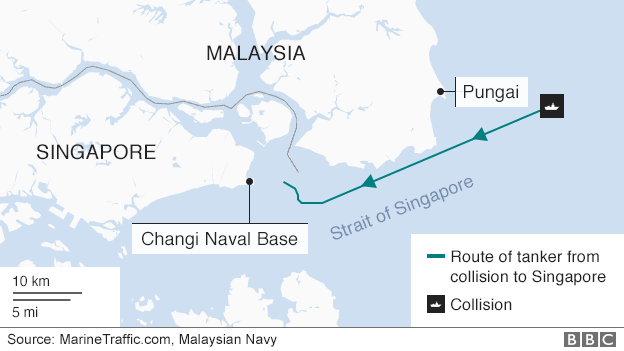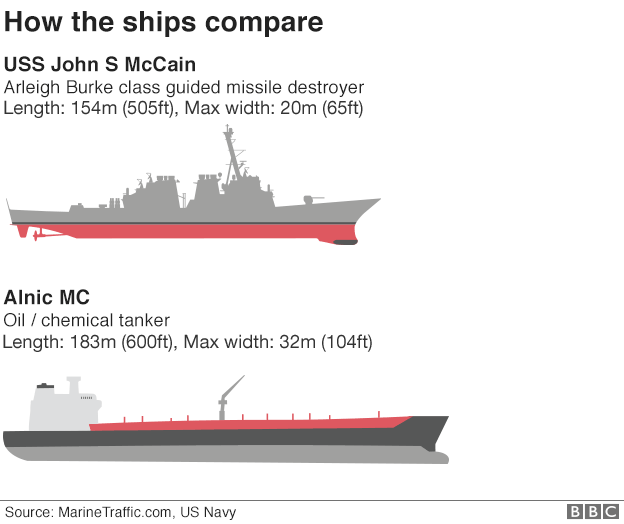US Navy collision: Remains found in hunt for missing sailors
- Published

The collision was reported at 05:24 local time on Monday east of the Strait of Singapore
Human remains have been found in the hunt for 10 US sailors missing after their destroyer collided with a tanker near Singapore, the navy says.
The discovery came when divers were sent down to search inside the USS John S McCain, now berthed at Singapore's Changi naval base.
The collision with a Liberian-flagged ship happened before dawn on Monday as the US vessel made a routine port call.
The US has since ordered a worldwide "operational pause" of its navy fleet.
It was the fourth crash involving a US Navy ship in a year, and the second in the past two months.
The collision ripped open the port side of the US vessel, flooding parts of the ship including crew compartments.
Admiral Scott Swift, commander of the US Pacific Fleet, said divers "were able to locate some remains in those sealed compartments during their search today".
The navy was also examining whether a body found by the Malaysian navy was one of the missing sailors, he said.
Ships, equipment and aircraft from the American, Indonesian, Malaysian and Singapore navies have been involved in the search for the missing sailors.
What do we know about the collision?
The USS John S McCain was east of Singapore when the collision occurred. It was reported before dawn at 05:24 local time on Monday (21:24 GMT on Sunday).

The destroyer sustained damage to her port side, which is the left-hand side of the vessel facing forward. Five sailors were injured, four of whom were medically evacuated to a Singapore hospital.
The tanker it collided with, Alnic MC, sustained damage to a tank near the front of the ship 7m (23ft) above the waterline, but none of its crew were injured and there were no oil spills.
The Alnic MC, carrying oil from Taiwan to Singapore, is currently at the Raffles Reserved Anchorage in Singapore.
What about the 'operational pause'?
The cause of the collision is not yet known, but Navy Admiral John Richardson, the chief of naval operations, has ordered fleet commanders to stop what they are doing for a day or two over the next week to "assess and review with their commands the fundamental practice to safe and effective operations".
The timing of this incident is awkward for the United States
He has also ordered a more comprehensive review "to find the contributing factors and root causes of the incidents".
"My hope is that we will learn, continue to improve in the short term, validating that we are sound on the fundamentals and if not then we'll take action to correct that, and then look at broader, more systemic issues that we may find through this comprehensive review," he said in a statement., external
He also said on Twitter that he would not rule out the possibility of some kind of outside interference or cyber-attack being behind the collision.
Allow X content?
This article contains content provided by X. We ask for your permission before anything is loaded, as they may be using cookies and other technologies. You may want to read X’s cookie policy, external and privacy policy, external before accepting. To view this content choose ‘accept and continue’.
What happened in the previous collisions?
This is the fourth time in a year that a US navy vessel has been involved in an accident.
Just two months ago, seven US sailors were killed when the USS Fitzgerald collided with a container ship in Japanese waters near the port city of Yokosuka.
Those who died were found in flooded berths on board the ship after the collision caused a gash under the warship's waterline.
The US Navy said last week that about a dozen sailors would be disciplined, and the commanding officer and other senior crew would be taken off the ship.
In May, a guided missile cruiser collided , externalwith a South Korean fishing vessel, while in August last year a submarine collided, external with an offshore support vessel.


USS John S McCain
Named after US senator John McCain's father and grandfather, both of whom were admirals in the US Navy, it is also known by its nickname Big Bad John
Operating from the US naval base in Yokosuka in Japan, it is part of the US 7th Fleet patrolling the Pacific
Has a crew of more than 300 sailors and officers. and a full displacement of 9,000 tons
In May, it successfully passed a navy inspection for mission readiness at sea, external
Alnic MC
Oil and chemical transporting tanker
Built 2008, registered in Liberia
Owned by Greece based Stealth Maritime Corporation
Heading from Pyeongtaek, South Korea en route from Taiwan to Singapore
Sources: US Navy, external, MarineTraffic.com, AFP